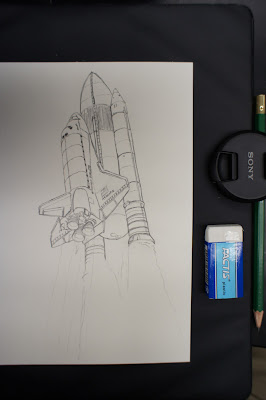Over this past winter break (before I returned to the craziness of geology thesis, petrology, or quantum physics II), I did a considerable amount of drawing - in the form of thank you cards. Using some blank stationary, and my huge supply of crayola pencils, I went to work...
First up on my thank you card lists were my research advisors and professors who wrote letters of recommendations for my graduate school applications. Over the winter break, I applied to a total of six different graduate schools in a range of astronomy, earth sciences, and planetary science programs - which meant I kept my letter writers busy! This drawing is of Buzz Aldrin, along with the Apollo 11 Lunar Module in the background and a seismometer (alongside Buzz).
This is card is of the space shuttle Enterprise, during the approach and landing test flights. What's unique about this drawing is that I avoided my usual, saturated pencil technique. Normally I don't really like leaving blank paper exposed (i.e. un-colored white space). This means that most of my drawings (like the Apollo 11 drawing previous) tend to be very heavily saturated with pencil (i.e. there's lots of graphite on the page). While I generally like this, it frequently doesn't photograph that well, since streaks of pencil will sometimes reflect and highlight particular pencil strokes, which then make the drawing as a whole look somewhat less professional. This also means I break my pencils very frequently, and spend a lot of time angrily resharpening. (This was one of the reasons I recently purchased some more expensive, but higher quality prismacolor pencils.) Maybe I should do a few more of this style in the coming weeks...
The last of the letter writer thank yous, this is a drawing of Voyager II, as it flies past Uranus. I based this drawing off a combination of self-composed Celestia images, and NASA diagrams of Voyager.
Now on to my Christmas and birthday thank you cards. This was a somewhat quick sketch of a Atlas rocket, which was used during Project Mercury (America's first manned space program).
A space shuttle, landing at Kennedy Space Flight Center in Florida.
An SR-71 Blackbird being refueled by a KC-135.
Mars Global Surveyor - for a certain someone at LPL, and her delicious cookies. This image was composed in Celestia.
This is a slightly more detailed drawing of the Space Shuttle Atlantis, during launch. In these two pictures you can see how I typically do these sort-of quick drawings (quick meaning on the scale of an hour or so). Usually, after finding my reference material (say a NASA image of the shuttle launching), I usually use a black pencil or a higher quality graphite pencil to outline my subject, and draw details. (This is another reason why I am constantly running out of black pencil.) I then go in and basically redraw the whole thing on top of it using color. (I say redraw, since the colored pencil typically overrides or smudges out all of the underlying guide pencil marks.)
Now, while I like doing it this way, since it's quick and gives everything a nice sharp look - I do so realizing that this is sort of the easy way out. Yes, these drawings look good, but in real life objects do not have black outlines. Take this photograph (that I stumbled upon on in NASA's image of the day) for example:
While there are certainly shapes that are outlined in black (such as the nose of the space shuttle), most boundaries or edges are not actually defined by black (or even white). Rather, edges are defined more so by shading and highlighting of a given object. For instance, look at the vertical rocket booster running up through the middle of the page (and behind the orbiter). Notice how there are no 'magical' black boundaries to the edge of the booster - rather the edge of the booster is defined by a juxtaposition of white and blue. In order to draw a picture like this (without the use of black edges), requires a lot more time and patience. Basically I must start out drawing in color, and rely heavily on dealing with negative space. While this has the potential to yield some really nice drawings, I typically don't have the patience to do this.
Here again is another progression of images of a drawing I did of the F-15 ACTIVE - a very colorfully painted test aircraft. Again, you can see that I like my colors bold and saturated!
And my last thank you card (for the moment) - a drawing of a Blue Angel F-18. Again, you can see my progression from outline (this time, actually navy blue, since I was out of black, and I already knew this was going to be a very blue-heavy drawing), to final product.
Now to make a jump to an entirely different kind of drawing:
I drew this sketch from life, during the Geology department graduate student talks at the beginning of this semester. It's a fairly big drawing, and took a lot of time (and I undoubtedly annoyed my fellow undergraduates in front of me with sharpening my pencils during the talk), but I was very pleased with this drawing. Drawing figures is extremely difficult, but something I like to try occasionally.
Well, I've now exhausted my supply of already drawn images. This now will put pressure on me to actually do some drawing over the next couple weeks to make some all new material to put up on here. (Although I'm also working on a post showing how I incorporate art into science). Until then, I better actually read my assigned paper on magmatic-hydrothermal ore deposits for economic geology (blah).















